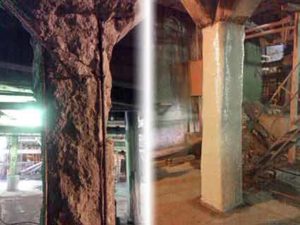†Structural Reinforcement of Concrete: A Sustainable Solution The challenge of reinforcing concrete structures isn’t just a local issue—it’s a global concern. We frequently hear about the decay of vital infrastructure like bridges, harbors, and water pipelines, but it’s the concrete itself, along with its reinforcement, that’s truly problematic. Modern concrete simply doesn’t last as long as it used to. In his book "The Concrete Planet," Robert Courland highlights how Roman structures made of concrete have endured for over 2,000 years, whereas contemporary concrete may only stand for a century, at best. Furthermore, cement production is the third-largest contributor to CO2 emissions globally, surpassed only by automobiles and coal-fired power plants. Replacing old infrastructure with new concrete carries a heavy environmental burden that we can’t afford to ignore. Fortunately, there are greener solutions, such as carbon fiber reinforcement, which not only save money but also minimize environmental damage. When a structure’s strength is compromised or needs enhancement—whether due to increased loads, corrosion of internal reinforcement, or external factors like vibrations or temperature changes—we must act. Cracks caused by these elements can be addressed, but when air, moisture, and chemicals infiltrate reinforced concrete, they cause the embedded steel to corrode and expand, leading to concrete spalling and eventual structural failure. This degradation affects everything from buildings and roads to bridges, dams, homes, airports, and more. Repairing concrete instead of replacing it is an eco-friendly option because it conserves energy. Cement production is incredibly energy-intensive, requiring vast amounts of coal, which contributes significantly to CO2 emissions. For every ton of cement produced, approximately one ton of CO2 is released. Carbon fiber reinforcement offers a sustainable alternative. Unlike traditional methods, carbon fiber is lightweight, easy to apply, and doesn’t add extra weight to existing structures. It’s also environmentally superior when considering the entire lifecycle, including transportation, energy consumption, and raw material usage. HJ3’s carbon fiber systems provide up to a 60-90% reduction in costs compared to complete replacement, allowing structures to last longer while cutting downtime expenses. Their products are widely used to strengthen columns, beams, walls, slabs, silos, and even underground utilities like pipes and manholes. By choosing carbon fiber over conventional repairs or replacements, we can significantly decrease our carbon footprint and preserve valuable resources. There are two main approaches to reinforcing aging concrete infrastructure. One is replacing it entirely with new concrete—a costly and environmentally taxing process. The other, more sustainable route involves using advanced composites like carbon fiber. Not only are these systems faster and simpler to install, but they’re also more economical when all costs—materials, transport, permits, labor, and downtime—are factored in. If you’re looking to reinforce your concrete structure and consider HJ3’s innovative solutions, feel free to reach out to our team of project managers at [insert contact details]. ††Aluminum Foil Paper Sandwich Wrap Aluminum foil snack bag,Cheap foil rolls,Oil-proof paper roll,Eco-friendly food paper rolls Qingzhou Xincheng Packaging Co., LTD , https://www.qzxcbc.com
